Project Description
DRILLING
Well Abandonments
Well Extensions
The abundance of quality, fresh water is one of Ontario’s greatest resources. Ground water comprises approximately 95% of our nation’s fresh water supply. Contrary to a widely held belief, ground water rarely exists in the form of underground lakes and rivers. Water is stored in layers of porous material known as the aquifer. It is into these layers of sand, gravel, and bedrock that water wells are drilled by Hanlon Well Drilling and Plumbing. Since ground water is a vital natural resource, it should always be protected from pollution. One way Hanlon Well Drilling and Plumbing can greatly reduce the chance of polluted surface water from infiltrating sources of pure water is through proper well location and construction. Our drillers make use of the latest dual rotary drilling equipment, as well as the most modern drilling procedures.
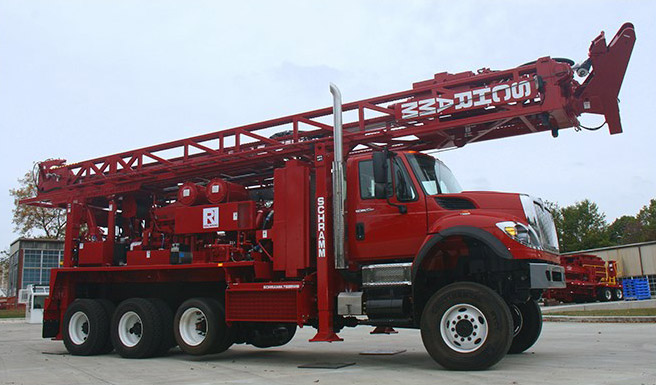
Hanlon Well Drilling and Plumbing has been installing water wells in southern Ontario since 1988. Knowledge of an area is of great importance when trying to find fresh water sources, the ground formations and the depth at which aquifers can be found will determine the drilling method that is most suited to each well. The Schramm dual rotary drilling rig that we use at Hanlon Well Drilling and Plumbing is the most efficient and fastest way to produce a well in the ground formations of Southern Ontario.
This method of drilling is an ideal way to set casing into formations in order to seal off the aquifer that is being tapped into from surface water exposure. Driving casing to into a confining layer (aquitard) seals off the porous material that is found on top of this layer, thus making it difficult for surface water to enter the aquifer that is supplying a home. A confining layer provides a natural filtration, the surface water moves extremely slow through the formation which pulls unwanted particles and contaminants out of the water through a natural process before the water reaches the aquifer. Allowing drinking water to go through this natural process creates a better water source as surface water is the most common reason for well contaminants. Hiring a contractor who has knowledge in how geological formations effect drinking water, and how to properly construct a well, will give your family the piece of mind that your water source has been developed with your health and well being as our main objective.
What You Need to Know as a Well Owner
- By law, if you have a well on your property, you are responsible for it!
Government of Ontario – Wells on your property - Well records in your area are available to the public.
Government of Ontario – Well Records Map - Government grants are available to anyone abandoning a well. Contact your local conservation authority as these grants are specific to each individual zone.
•Grand River Conservation Authority
•Hamilton Conservation Authority - Anyone servicing a well must hold an Ontario Well Technicians Licence.
Government of Ontario – Wells Regulation 903
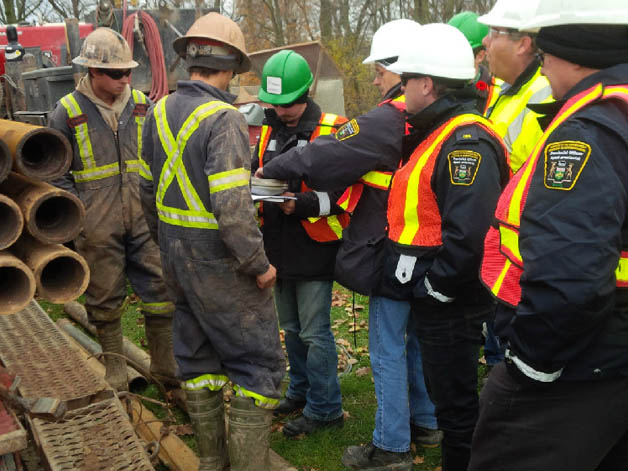 Training being provided by our team for the Ministry of Environment
Training being provided by our team for the Ministry of Environment
Deep Wells
As mentioned in the previous dialogue, deep wells are the most common and preferred water wells installed today. Studies have shown that dated and shallow wells are commonly exposed to contaminants, surface water reaches the water source without properly being filtered through the ground formations. Deep wells at a 6″ diameter are the preferred method of constructing new water wells, the depths that are reached provide an abundance of filtration formations for the surface water to be purified through.
The following diagram shows the value of a deep well, installed through an aquitard layer in comparison to a shallow well, as well as the depths contaminants can extend.
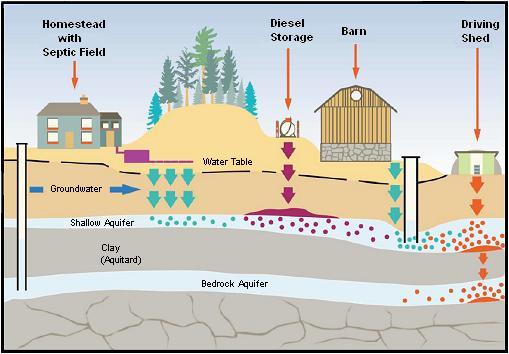 gov.on.ca website
gov.on.ca website
Old Wells
All wells have a lifespan like most things do, after an extended period of time well casing will begin to deteriorate and may fail to provide a seal from surface water. These wells should be decommissioned and a proper 6″ cased deep well installed to protect the aquifer from contamination. A single aquifer can span over a large distance, therefor multiple homes could be using the same water source. The proper steps should be taken to ensure the safety of your water supply as well as your neighbours.
Dug or Bored Wells
These wells are the most vulnerable to contamination. Most of these wells are extremely shallow and are installed with 36″ diameter concrete casing, the concrete casing is set in 36″ sections (in most cases) and provide almost no water tight seal at each connection. Each connection is a point of contamination as water can enter the well almost directly from surface, with little to no filtration before entering the water source. This style of well is usually under direct influence from surface water and can easily be contaminated by pesticides, fertilizers, house hold pets, rodents and more. Dug or bored wells are still used in today’s market but are only recommended in areas where surface water is the only available source.
Case – Dug Well & Drilled Well
The image below is of a bored well that has had a 6″ cased well installed inside of the 36″ concrete cased well. This is not recommended and is not up to code, the original concrete casing acts as a bowl to hold standing water that can protrude past the well casing and enter the well. The 6″ well casing in this case can be extended above surface, the concrete casing will be removed, and the surrounding annulus of the 6″ steel casing properly filled with 20% solids. This following image depicts how easily a dug or bored well can become contaminated through the concrete joints.
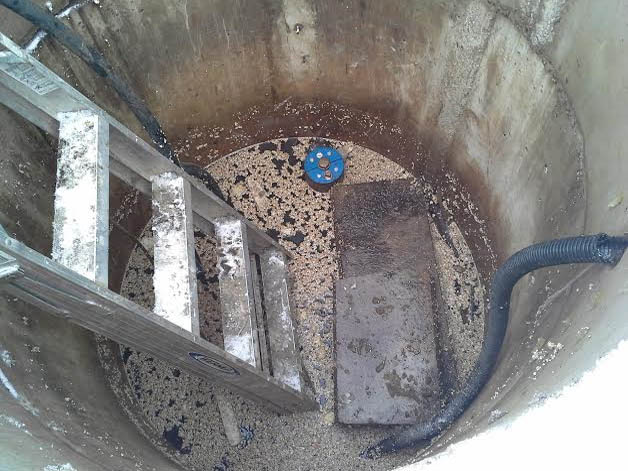 Before – Clearly showing debris entering well pit and contamination source
Before – Clearly showing debris entering well pit and contamination source
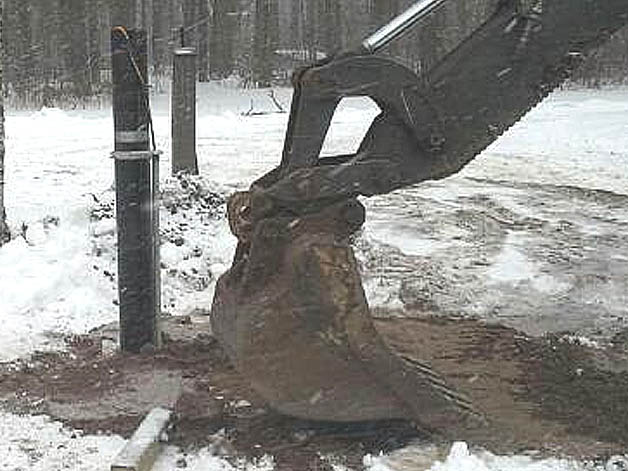 After – Well extended above grade and well pit removed. Casing was sealed with bentonite sealant to ensure no water from surface can travel down the side of the casing. Casing was later cut to 16″ above ground level and a vermin-proof cap installed.
After – Well extended above grade and well pit removed. Casing was sealed with bentonite sealant to ensure no water from surface can travel down the side of the casing. Casing was later cut to 16″ above ground level and a vermin-proof cap installed.
Well Abandonment
Abandoning a well (or decommissioning) a well is important to protecting our fresh water sources from contamination, especially when a new well is being drilled as a replacement. If a well is outdated, improperly installed, or produces mineralized water, the proper steps should be taken to ensure the well is sealed off. According to Regulation 903 a minimum of 6′ of casing should be removed from surface, and the remaining opening be filled with hole abandonment material. Using fill that is not accepted by the Ministry of Environment can lead to aquifer contamination which can result in related health effects. Always remember that your neighbours could be drinking the same water!
Government grants are available, contact your local Conservation Authority for details as grants are specific to each zone. Hanlon Well Drilling and Plumbing preforms many well abandonments each year for the Conservation Authorities in our region. There are very specific guidelines that need to be followed when abandoning a well and appropriate equipment that coincides with each process. We are well equipped to handle the decommissioning of most types of wells.
Well Extensions
According to Wells Regulation 903, a well must protrude above ground surface by 16″ or more from the highest point on the ground surface within 3 meters radially from the outside of the casing. This means that a drilled well that is located inside of a well pit is not up to code and should be extended. We can add to the casing that is in the well pit, remove the well pit, and fill the annular space around the well with the proper material to bring the well up to code. As you can see in the case above, these pits can cause a serious issue with the integrity of your water source. If you have a well pit or your well is buried, it is time to get your well up to code.
Cistern Installations
Cisterns are a great solution for a low flowing well or a build where no water is available. Cisterns are large holding tanks that can either be filled by a water truck or by a well. If a water well has a low yield (output) then a cistern may be installed along with a flow control and a float. The float will draw indicate to the well pump that the water level is getting low, the flow control valve will only let the amount of water the well is able to produce through, thus keeping the well from running dry.
For example, if a well only produces 2 gallons per minute, the water demand may be greater than the well output at certain times of the day, and the well will not be able to service that demand. If a cistern is installed the well can feed the cistern at a volume in which the well can handle, in this case a flow control would allow a steady flow of water to enter the cistern until it is full. The well then rests and the water supply to the home comes from the cistern only, until the cistern runs low on water again.
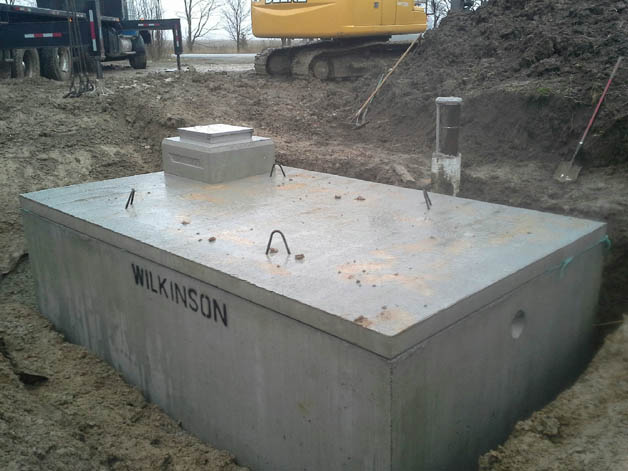 Concrete cistern installation
Concrete cistern installation
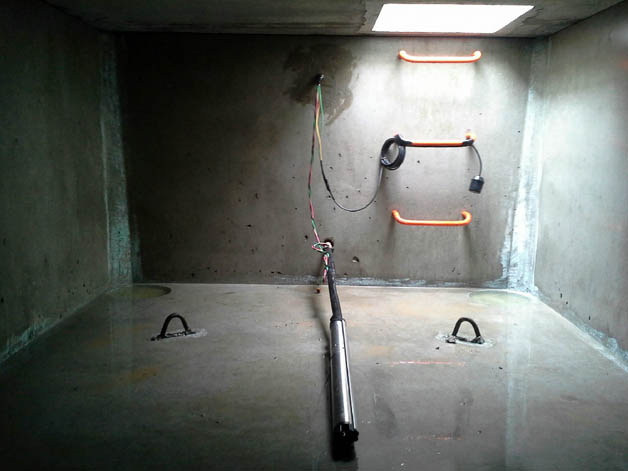 Inside the cistern, pump with low level alarm.
Inside the cistern, pump with low level alarm.
FREE QUOTE
Do you need help with a water related issue? Fill out this form to get in touch.

